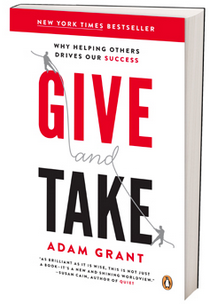Give and Take – Adam Grant

The book hinges on a distinction Grant makes between “selfless” giving and “otherish” giving. It’s the difference between being a burned out disaffected doormat for others and creating a way of helping others that assesses more clearly an investment strategy that moves everyone forward. His case studies and profiles are really interesting. The real people he introduces us to (some agreed to use their real names and some use pseudonyms) find their way toward this “otherish” style of giving through a variety of means.
One young Teach for America teacher ended up starting a nonprofit to coach promising disadvantaged students interested in continuing their education in addition to her overwhelming day job as a high school teacher in a tough Philadelphia school. Doing something that was impactful and meaningful energized her and motivated her beyond the discouraging daily routine she had in the classroom. Ultimately, it affected her classroom environment in a positive way and she ended up creating an informal mentoring program among her fellow teachers.
Grant points out that Americans culturally are not at ease with the idea of altruism. He quotes Alexis de Tocqueville’s observation from the 18th century that Americans are very generous people but cloak that generosity in explanations of self-interest. Grant points out that many people hide their generosity, particularly in the workplace, where they may help others around them but don’t want to be perceived as “giving it away.” It’s an interesting cultural paradigm and this book explores it very well.
There are so many concepts in this book that resonate with me. I found it a very engaging read and bookmarked things from the first chapter to the last. One of the fascinating aspects of his research is how bad we are at predicting our own motivations as well as the motivations of those around us. We believe we know what other people think, feel and value in the workplace and his research shows compelling evidence that we are wrong a great deal of the time.
The application of what this book has to say can be used in our interactions everyday, not only in the workplace, but any place where we are working, collaborating and connecting with others. In one section he talks about raising money and how fundraisers projections of how many donors will be needed to raise a targeted amount of money is always greater than the reality. This was a standout for me: “When we try to predict other’s reactions, we focus on the costs of saying ‘yes’, overlooking the costs of saying ‘no.” This book is full of those kinds of “aha” moments.
I found the book very useful and would highly recommend it . . . to everyone!